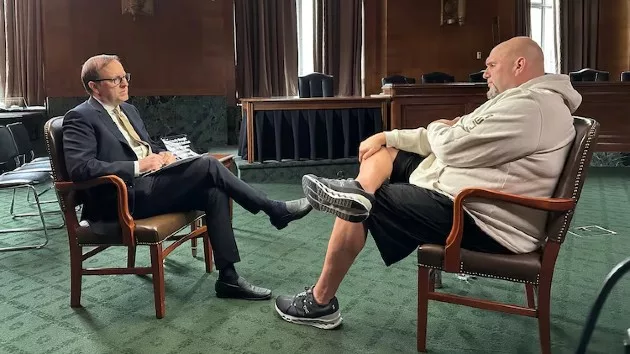
(WASHINGTON) — As Democrats and Republicans wage electoral war for control of Congress and 36 governors’ mansions as well as victory in numerous state and local races, voter ticket-splitting — a trend operatives thought to be nearing its political death or to already be buried — is reemerging in polls as a potential curveball in close races.
In at least 10 states hosting Senate and gubernatorial contests, surveys have for several weeks indicated a sliver of voters bucking the growing trend of party-line ballots. That could prove decisive in narrow elections to determine control in Washington next year and to choose state leaders who’ll shape policy on abortion access, voting rights and more.
Analyses from the Pew Research Center and others had suggested that ticket-splitting, especially in top-ballot races, was on the decline in recent cycles.
“Back in the old days, normally it was 40-40 [percent each] and then the 20% of middle that you’re fighting over. I think that middle area there, where technically you think of ticket-splitters, is substantially less than it used to be. I think it’s probably 92% are pretty predetermined, and then you have probably that 6%, 8%,” said one Ohio GOP strategist.
But amid a confluence of factors, from massive gobs of money thrown into campaigns to fractured party bases to incumbent advantages to candidate quality and more, strategists from both sides of the aisle are forecasting that more voters this cycle than in previous midterms, including in 2018, will choose a Democrat for one race on their ballot and a Republican for another.
“I think that if we are comparing governors’ races to Senate races or to congressional races, you can expect to see a pretty good amount of ticket-splitting,” said Molly Murphy, a Democratic pollster working on several midterm campaigns.
Murphy believes it’s because people want different things out of different offices: “When it comes to … an executive versus a legislator, voters are able to use more varied criteria.”
One study of decades of voting data by the Brookings Institution showed that the correlation is growing stronger between which parties voters choose in congressional races and in presidential contests — meaning voters usually pick the same party. The percent of ticket-splitting, according to this analysis, began to decline into the single digits in 2012.
Yet if the trend returns in November, matching the expectations from swing state polls — a big if, though experts say it’s possible — it would mark a comeback for what had been a somewhat common practice.
FiveThirtyEight’s polling average shows Josh Shapiro, Pennsylvania’s attorney general and the Democratic gubernatorial nominee, leading Republican Doug Mastriano by nearly 9 points. Meanwhile, Lt. Gov. John Fetterman, the Democratic Senate candidate, is leading GOP rival Mehmet Oz by less than 3 points.
Georgia features a similar dynamic, where FiveThirty Eight polling averages show GOP Gov. Brian Kemp up over Stacey Abrams by more than 6 points but Democratic Sen. Raphael Warnock leading in his reelection bid by 3 points against Republican hopeful Herschel Walker.
In Ohio, Republican Gov. Mike DeWine is coasting in his campaign against Nan Whaley, with a nearly 20-point lead in polling averages, while Republican Senate candidate J.D. Vance is only ahead of Democratic Rep. Tim Ryan by under 2 points.
And in Arizona, GOP firebrand Kari Lake has a slim 1-point edge in the governor’s race against Democratic Secretary of State Katie Hobbs while Sen. Mark Kelly is up by roughly 5 points against the GOP’s Blake Masters.
Ticket-splitting still occurs in modern politics. For instance, Sen. Susan Collins, R-Maine, handily won reelection in 2020 even as Joe Biden romped there. But it is a far cry from the 2000 election cycle, for example, when 10 senators won in states that their parties’ presidential candidates lost.
This year, various themes are at play and none is identical to any other. However, one common thread strategists say is contributing to ticket-splitting is the surge in money being spent on midterm races, leading to heightened awareness of candidates beyond just their party affiliation.
“Voters get to know those candidates and who they are and, therefore, they’re not going to vote party line. They’re gonna vote as to which candidate they prefer,” argues veteran GOP strategist Bob Heckman.
Conversely, however, some Democrats said that in cases of their own ticket-splitting woes — like Whaley lagging Ryan in Ohio — it’s because the entire ticket didn’t fundraise enough to build a profile with voters separate from the party.
“You have Senate races and governors’ races where the Senate race does better than the governor’s race for the Democrats. And what seems to be happening is, overwhelmingly, the governors’ races just don’t raise the same kind of money and they don’t have the same kind of ability to reach voters,” one Democratic strategist said.
“And that disparity means that in Senate races, you can inspire people at the local level all over the country to give $20, $30 to your campaign. But it’s very hard to persuade someone in New York that what happens in the Oregon governor’s race matters to them,” this person added.
The midterms are also taking place as both parties’ bases continue to transform and, especially among Republicans, fracture further.
Democrats’ years-long divide between moderates and progressives has played out for several cycles. Now, GOP politicians in swing states are choosing how to angle their appeals — either to Donald Trump-aligned voters or to more centrist suburbanites who used to make up the GOP’s core and who have been key in some past races.
In several states, Republicans like DeWine, Kemp and Oz, whose brands are somewhat removed from the former president, are outpacing their more populist counterparts. And while some MAGA candidates like Lake are still polling strongly, surveys indicate the need for a broad appeal in a statewide race.
“What you’re looking at as far as tickets-splitters, [they] are probably going to come from the suburbs … those folks that voted Republican but weren’t all that keen on Trump,” one Ohio GOP strategist said. “That’s where you see DeWine with anywhere from a 15-19-point lead right now, and then the race for the U.S. Senate is much smaller.”
“I think there will be a lot more Shapiro-Oz voters than there will be Mastriano-Fetterman voters. And there’s starting to be a little bit more of a separation between Mastriano and Oz. I think they’ll do pretty much the same with Republicans, maybe Mastriano a little bit better than Oz. But then I think among independents and Democrats, you’ll see Oz doing better than Mastriano,” a Pennsylvania Republican strategist added.
Beyond ticket-splitting, the diverging party bases could also lead to what Jarrod Loadholt, a partner in the Ice Miller law firm’s public affairs branch who lives in Georgia, dubbed “ticket sitting.”
“I feel like there are very strong views of Brian Kemp in certain corners of the state, just like I think there are very strong views of Stacey Abrams. There are strong views of Herschel Walker, but I think there are strong views on both sides such that Republicans may skip that race altogether, and they just vote for Brian Kemp,” Loadholt, who supports Warnock and Abrams, told ABC News.
“I do think the combination of ticket-splitters and ‘ticket sitters’ will play a role in the ultimate outcome of this race, absolutely. And yes, there is a Warnock-Kemp voter,” he said.
Election cycle fundamentals are also certainly influencing the potential for ticket-splitting, strategists insist.
Incumbents often have an advantage owing to higher name identification, more well-known records and beefier war chests that make it easier to reach voters — a dynamic that could help explain polling leads for both Kemp and Warnock. And, some of the operatives note, female candidates often get examined under a different set of standards than their male counterparts, which could be hurting Abrams.
And while subjective opinions like on “candidate quality” are often made in the eye of the beholder, such judgements are still set to play a role — however unquantifiable — in November, the race experts said.
“I think ultimately there are gonna be some people who voted for Trump in ’16 and ’20 and they’ll go vote for Warnock because they may like him for X number of reasons around insulin, like he’s made a big deal about [the cost of] insulin at rural hospitals. But they may be Trump people, so they’re not Kemp people,” said Loadholt.
“Voters themselves can be far more candidate-driven and less ‘ideological’ than hardcore observers of politics and hardcore ideological folks,” he said. “There are lots of voters who are ‘feel voters,’ they vote based on what they feel.”
Copyright © 2022, ABC Audio. All rights reserved.





